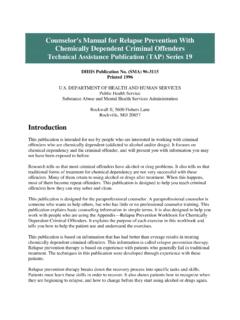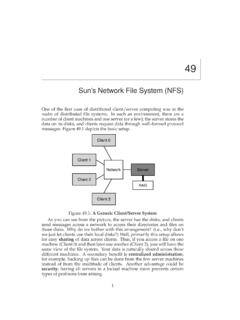Transcription of Step by Step: Doing a Data Recovery with GetDataBack
1 Step by Step: Doing a Data Recovery with GetDataBackHere's how you do everything right when Doing a data Recovery with GetDataBack :Do not write anything anymore to the drive you want to recover the data from!This principle is not meant to terrorize you, it's meant to preserve your data. After a data loss your data is notprotected by the Operating System anymore the way it was before. The OS thinks that the space where your lostdata resides is free and can be used. This means that the next copy operation, installation of programs, Internetsurfing (which generates temporary files) and even booting from the drive can permanently overwrite your Set up a Recovery ComputerNext we will describe how to set up a Recovery you do anything else, do the the drive you want to recover your data from is your Master/Boot-Drive (C:), then remove it from thesystem and attach it to another computer as a slave/second drive.
2 We'll show you how the drive with the lost data is a second or external drive (please see the ) you may leave the setup as it is. Please jump your drive is a laptop or notebook drive, please go to Remove the drive and attach it as a slave driveIf you haven't installed a drive before, please follow these easy of all - shut down your computer and unplug the power cable. You then need to open your computercasing, that's just a few tiny screws. You'll see your hard drive connected to the IDE cable and a powercable. You will probably need to unscrew a few more screws to free your hard drive. Then unplug the drivefrom the IDE cable and the power cable. That's it. Take the drive and install it to another have two choices:- If you have another working computer, just install the drive as a slave drive to this one. Please be awarethat you have to have enough free space on the hard drive of this computer to copy the recovered files course you can use a friend's computer for this - make sure your friend is okay with you coping all yourrecovered data to his If you don't have a second working computer, you can also set up your old system as the RecoveryComputer.
3 Just get another hard drive with enough space to later hold the recovered data and install anyWindows OS on it. Make this drive the Master/Boot drive of your computer and attach the "problem" driveas a slave the drive as a second/slave drive. You first need to jumper the drive as a slave drive. There arelittle pins on the small side of the drive, which you have to set to the right position for slave/secondaccording to a chart that's usually on the drive. All you need to do then is to plug the "problem" drive intothe second slot on the IDE cable. It also needs power, make sure to connect it to one of thered/yellow/black power plug the main power cable back in and start up the Recovery Computer. Make sure that the seconddrive is detected. Check this in Windows Disk Management. To get there click Start>ControlPanel>Administrative Tools>Computer Management>Storage>Disk Management.
4 If your drive doesn'tshow up here, the drive is either physically damaged or not installed correctly. If you know or suspect thatthe drive is broken, you need to send it to a data Recovery lab. Otherwise, check the cabling and makesure the drive is jumpered as a slave drive. If that doesn't help, take the computer to a local computerstore and ask for Special - What if your drive is a Notebook/Laptop drive?If you need to recover data from a Notebook or Laptop drive, you can the drive from the Laptop/Notebook and attach it to the IDE-cable of a Desktop computer. You'llneed to find out how to remove the drive from your computer, normally with modern Notebooks/Laptopsthe drives are removable and it's just a screw or two to get them out. Don't forget - always power downyour computer before you remove hardware. As soon as you've managed to remove the drive you'll needa Notebook-to-IDE-adaptor which you can get at any computer store for under $15.
5 Jumper your drive asa slave and connect it via this adaptor to any Windows alternative is to create a WinPE/BartPE boot disk and run GetDataBack from there. This is morecomplicated, but works just as well and is an option if you cannot remove the drive from the be aware that later on you need sufficient space on another drive to copy the recovered data can for example be an USB-Drive that you attach to the Notebook or a Network drive. You'll finddetailed information on how to create a WinPE/BartPE boot disk on our website simpler option is booting the Notebook from our ready-to-use Runtime Live CD. This CD-ROM hasGetDataBack preinstalled. You can download the ISO image from our Website Special - External DrivesExternal drives, like for example USB-Drives, can be recovered with GetDataBack just like internal - scanning the drive for your data takes much longer when performed through USB, especially when usingUSB1.
6 The scan can be up to ten times longer, so while scanning a 100GB drive normally takes about 2 hours, itcan be up to 20 hours through USB. If at all possible, remove the drive from its casing and attach it directly to theIDE-cable of your computer. If you are afraid that unwrapping the drive is going to void its warranty, leaveeverything as it is and be Install GetDataBackThe hard work is behind you. Now that you've set up your Recovery Computer, download the free demo version ofGetDataBack from our website. There are two versions: GetDataBack for FAT recovers data from FAT-formatteddrives, GetDataBack for NTFS recovers data from NTFS-formatted you don't know whether your drive was FAT or NTFS, here's a little guide which product you need:If the Operating System on your "problem" drive was Windows 95, 98, ME or you are dealing with a Compact FlashCard, USB-Stick, an external drive which you never formatted or a floppy disk, the file system is most likely FATand you'll need GetDataBack for the Operating System was Windows NT, 2000 or XP the file system probably was NT and you'll need to useGetDataBack for NTFS.
7 Please note: XP uses both file systems, so with XP it can be both FAT or NTFS. Drives largerthan 32 GB are NTFS most of the you're still not sure which version you need: It doesn't hurt just to try either GetDataBack for FAT or NTFS,you're not going to damage anything by using the wrong version. If after the scan in Step 2 of the software youdon't see any useful file system entries, simply start over and try the other GetDataBack on the Master/Boot (C:) drive of your Recovery Running GetDataBackStart GetDataBack by clicking on Start>All Programs> Welcome ScreenThe first screen will look like Intro ScreenThe only decision you'll have to make here is to pick one the data Recovery scenarios. Read through the choicescarefully and then choose the one that most applies to your situation. Don't hesitate to go with the standardoptions if you're not sure what happened to your drive.
8 The standard options are the recommended settings formost recoveries and more often than not they will produce the optimal Recovery Step 1 - Select DriveStep 1 will look like Step 1 ScreenOn the left hand side of Step 1 you'll get a list of all the drives that are accessible in your system. Now you willselect your "problem" drive from this list. If you attached the drive as a slave drive as explained above this will bethe entry "2nd Hard Drive (HD129:)" or if you had more than one hard drive in the system already it could be the3rd, 4th or so hard drive. It shouldn't be "1st Hard Drive (HD128:) because that would mean the drive you want torecover the data from is still set up as the boot the drive you want to recover underPhysical Drives. Choose the entry under Physical Drive over any onesunder Logical Drives - this will usually yield the best is usually no need to change any options manually in the Options tab on the right hand side.
9 Refrain fromchanging any settings in Partial Scan - this feature is for experts only and will not improve your Recovery Scanning the DriveGetDataBack will now scan your drive for every available information regarding the original file system. The scanwill take some time, you should at least allow an hour of scanning for every 50 GB of drive - if the scan takes much longer than this, there is something wrong. It is normal if the scan is notcompleted within a couple of are the a couple of reasons why the scan can take very drive has aphysical problem. If the drive has a lot ofbad sectors(damaged areas on the drive'splatters that cannot be read anymore) or is otherwise damaged, the scan can take really long if it's evergoing to you get only an occasional bad sector message, but the scan is otherwise progressing, choose "Ignore"in the warning windows and let the scan if you receive a lot of read error messages, or the scan seems to stall or is taking forever, your bestbet is to stop what you are Doing and to make an Image of your damaged drive first.
10 By making an Imageyou will reduce the stress on the drive (which if physically damaged can fail at any moment). Once youhave created the Image you can perform the data Recovery for the Image instead of the drive - just selectthe Image you made in Step 1 of GetDataBack (Image Files). You can use GetDataBack to make anImage, the only other thing you'll need is enough space on another drive to store the Image on how to create an Image are on our website are scanning anexternal drivethrough the USB port. Scanning a drive through USB takes muchlonger than scanning a drive that is connected to the internal IDE-cable of your computer. In extremecases the scan can take 10 times longer, especially when using USB1. Consider taking the drive out of itscasing and attaching it directly to the IDE-cable. See Step 2 - Select File SystemIn Step 2 you will Step 2 ScreenOn the left hand side of the screen you will see a list of the possible file systems GetDataBack has found.








![Your Rights In Christ [Revised] - Yola](/cache/preview/d/c/a/e/8/f/7/d/thumb-dcae8f7df2d8f6636448f5564caba782.jpg)
